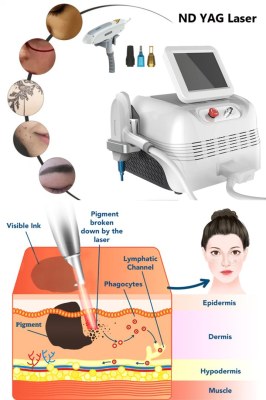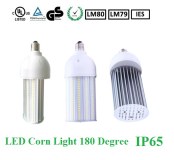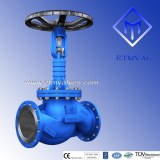Although getting a tattoo may seem like a very good idea at first, our opinion may change over time and we may not want to see our tattoo anymore. Thanks to the developments in laser technology, it is possible to safely and effectively remove the permanent ink used during the tattooing process from the skin. While laser therapy is arguably the best way to have a tattoo removed, the equipment involved plays a big role, Q switched ND YAG laser tattoo removal is considered the most superior in this category.
The journey of tattoo removal can be a long, tedious process, but the combination of the best equipment can not only speed up the process significantly but make the journey a more pleasant and manageable experience. Q switched 1064 ND YAG laser technology uses three different wavelengths during laser treatment. These wavelengths can target all tattoo colours effectively. If you're looking to learn a bit more about how we use Q switched lasers to remove your tattoo, here's what you need to know.
How does Q-switched ND YAG laser work in tattoo removal?
Q-switched ND YAG laser machine used in tattoo removal break the artificial pigment into small pieces. Pieces of ink that are cut into small pieces are removed by cells that are part of our immune system, which we call macrophages. Completion of laser pulses within nanoseconds is one of the most important factors preventing the burning of the tissue around the pigment and the formation of scars. Another important factor is that sufficient energy reaches the tissue for pigment breakdown. High energy levels can cause tissue damage, while low energy levels may be insufficient to break down the pigment.
Regardless of the type of laser equipment used, the same basic process occurs during laser tattoo removal, so it's worth having a basic understanding of the process before diving into Q switched lasers. A tattoo removal laser sends out an extremely fast laser beam of light energy into the skin. This penetrates deeper than the top layer and can reach the dermal layer of the skin, where the tattoo ink particles are housed. Each zap from the laser beam breaks the ink particle down into multiple smaller pieces. The feeling of the laser beam hitting each spot has been compared to an elastic band snapping against your skin quick and then over. Thankfully, most laser treatment sessions only last a few minutes, depending on the tattoo's size. Laser tattoo removal treatments are used over time to break all the tattoo ink particles down into small enough fragments so that they can naturally be released from the body.
What are the side effects of tattoo removal?
As with all procedures, ND YAG laser treatments also carry some risks. Possible side effects: light-dark discoloration of the skin, darkening of the tattoo, blistering, allergic reaction or development of scars may occur. The likelihood of these side effects may vary depending on the tattoo structure, the device used and personal characteristics. Blistering is a condition that can be seen during the normal recovery period after the procedure. Skin care is very important during the recovery period after the procedure, so it is recommended that you choose an experienced specialist who can follow your healing process together with you, after laser application.
Like any laser tattoo removal, Q switched ND YAG laser tattoo removal isn't a quick-fix solution. Instead, it requires adequate aftercare and patience between sessions. The Q switched laser, in particular, could result in hypopigmentation around the treatment site following treatment. This means that the skin could discolour temporarily. Q switched laser tattoo removal generally can lead to blistering after treatment. Although blistering is considered a good thing as part of the healing process, it can be itchy, sore and unpleasant. In addition, not caring for blisters correctly can lead to significant scarring. Depending on your pain tolerance, you may perceive Q switched laser tattoo removal to be painful. This is especially true if you have a large tattoo.
Ideal candidates for a Q-switched laser
1.Individuals who are seeking pain-free, non-invasive skin rejuvenation procedures.
2.People with tattoos who want them removed.
3.People with pigmented lesions, such as age spots or sunspots.
4.The individual has to be healthy enough for a laser treatment.
5.Pregnant women or those who are breastfeeding are not candidates for laser treatments.
6.People with a history of herpes simplex or other skin infections should not have laser treatments.
Care Before ND YAG Laser Procedure:
1.Before beginning the procedure, the physician will evaluate how you respond to test spots.
2.Ensure to wash face and remove all makeup before the procedure.
3.You should also avoid sun exposure before and after the treatment.
4.If you are pregnant, breastfeeding, or have a pacemaker, you should not have the Q-switched laser procedure.
5.Follow your physician's plan and treatment instructions.
Recovery after Treatment:
1.It is a quick procedure that is completed within 15 minutes.
2.There is no downtime. The patient can get back to their normal work immediately after the procedure.
3.Apply moisturizer to moisturize and hydrate your skin.
4.Drink plenty of water to keep your body hydrated and it helps in fast healing.
5.Apply SPF of 30 or above and try to avoid sun exposure as much as possible.
6.Do not touch or rub the treated area and avoid wearing tight clothing.
7.Avoid using cosmetic products that contain or retinoids for about three days.
8.Avoid vigorous activities, consumption, and smoking until your doctor suggests.
Potential Complications:
Complications from ND YAG laser treatment are usually minor and may include:
1.Pain during treatment, which can be reduced by contact cooling and if necessary, topical anaesthetic.
2.Redness, swelling and itching immediately after the procedure. This may last only a few days after your procedure.
3.Blistering, which occurs rarely when the skin pigment absorbs too much light energy. This should resolve on its own in a few days.
4.Changes in skin pigmentation, which may happen if the pigment cells (melanocytes) get damaged, leaving darker (hyperpigmentation) or paler (hypopigmentation) patches of skin. Generally, cosmetic lasers will work better on people with lighter rather than darker skin tones.
5.Bruising, which only affects up to 10% of patients. It usually fades on its own.
6.Bacterial infection.
How many sessions does ND YAG laser tattoo removal take?
Although it varies according to the structure and location of the tattoo, an average of 2-6 sessions with an interval of 6 weeks can be recommended.
Ultimately, your best bet is to book a consultation and have an expert assess your tattoo and discuss the different laser systems available. They'll also be able to advise on the number of treatment sessions required.
Localisation : HENAN NEW-TECH MARKET.NO 199, YANG JIN ROAD, JINSHUI DISTRICT ZHENGZHOU, CHINA., 450003 Zhengzhou,
Personne à contacter : Best Bvlaser, 0086 19503862093







